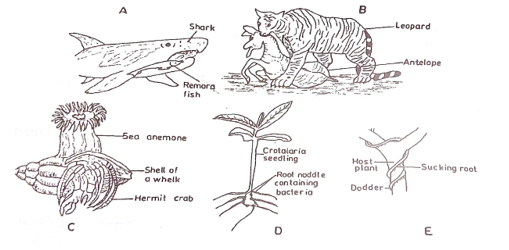Question 2
-
The diagrams below are illustrations of organisms in biological relationshipsStudy them and answer questions 2(a) to (e).
- Name the relationships shown in illustrations A to E [5 marks]
- Give the relationships under the headings: Beneficial or Harmful. [5 marks]
(i) State two relationships in the diagram in which only one organism benefits. [2 marks]
((ii) State two relationships in the diagram in which both organism benefit. [2 marks]
(iii) State one relationship in the diagram in which one organism is totally harmed. [1 mark]
- State one other example of the type of relationship that exists in each of the diagrams illustrated as A, B, C and E. [4 marks]
- Describe briefly the relationship that exists in:
(i) the diagram illustrated as C; [3 marks]
(ii) the diagram illustrated as D. [3 marks]

Observation
There was a poor response to the relationships by some poor candidates that could not identify the types of relationship between the organisms illustrated, hence they could not state other examples of organisms involved in similar relationships. The candidates who were able to identify the relationships correctly and group the relationships as either beneficial or harmful scored very high. Most candidates could not correctly name the relationship that exists between the Hermit crab and Sea anemone as well a legume plant and the bacteria in the root nodule.
The expected answers are:
1.(a) Name of relationships
A – Commensalism
B – Predation
C – Mutualism
D – Mutualism
E – Parasitism
(b)Grouping of relationships
(c)The relationship in which
(i) One organism benefits
A /Commensalism
B /Predation
E /Parasitism
(ii) Both organisms benefit
C /Mutualism
D /Mutualism
(iii) One organism is totally harmed
B
(d) Other examples
A – Correctly named epiphytes and trees/correctly named trees/any correctly named example;
B – Eagle/Hawk/Kite and chick/any correctly named carnivorous plant/any correctly named example;
C – Protozoa/Trichonympha/flagellate in the digestive tract of termites//any correctly named example;
E – Round worm in the intestine of animals/vertebrates/mistletoe on plant/any correctly named example.
(e) Relationship that exists in the diagram illustrated as
(i)C
- The hermit crab lives in the empty shell of a whelk/Mollusc/snail;
- The sea anemone also attaches to the empty shell that contains the Hermit crab;
- To enjoy movement;
- And to enjoy food/nutrients from the environment;
- While giving protection to the Hermit crab.
(ii)D
- The bacteria in the root nodules obtain carbohydrate/nutrient from the plant;
- While the plant gets ammonium compounds from the bacteria;
- The nodules provide shelter for the bacteria.
